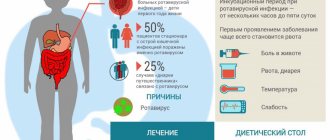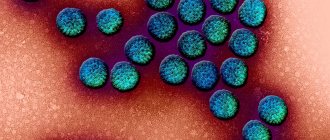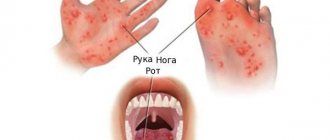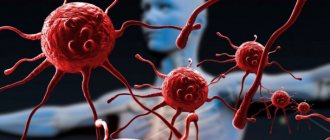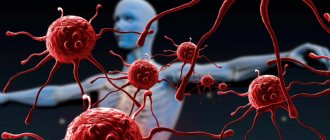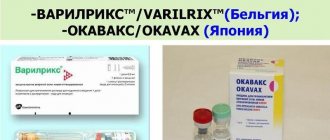Dermatovenerologist
Khasanova
Alina Rashidovna
8 years of experience
Make an appointment
HPV, also known as human papillomavirus, is not a single virus, but a whole group of them. They are transmitted from person to person (usually sexually) and become the cause of papillomas - benign formations. Some of these viruses are oncogenic, that is, they increase the risk of developing malignant tumors, for example, cervical cancer. But HPV is dangerous not only for women, but also for men, as well as for children.
Development and localization
To begin with, it is important to note that there are more than 600 strains of this virus. That is, there is not one diagnosis, one version of the consequences and one version of the manifestations. There are many different situations involving infection.
If the immune system is strong, it can easily cope with the virus on its own and within a few years “displace” it from the body. But at the same time, re-infection or illness with a different strain is also possible.
Papillomas and other symptoms of HPV in the form of formations that develop as a result of infection can appear in different places:
- on the skin anywhere;
- in the anogenital area;
- in the oral cavity, bronchi and upper respiratory tract;
- in the rectum, etc.
Formations can grow and form entire groups, or they can gradually dry out and disappear - it all depends on the specific situation.
Clinical picture
Condylomata acuminata are formations of flesh-pink color, lobulated, ranging in size from 2 millimeters to ten centimeters, with exophytic growth, in which the apex of the genital condyloma is often wider than the base. Externally, the growths may resemble cauliflower or cockscomb.
The incubation period can range from 2-3 months to 2-3 years or more. The growth rate of formations varies, which is often associated with the state of local immunity, the presence of concomitant STIs, and sexual activity.
HPV strains
There are strains of the virus that have a high oncogenic potential. They are designated by numbers 16, 18, 39, 45, 56, 68, 73 and 82. There are also options with medium (26, 31, 33, 35, 51, 52, 53, 58 and 66) and low (6.11, 40, 42, 43, 44, 54, 61, 70, 72, 81) oncogenicity. Cervical cancer is most often associated with infection with strains 16 and 18, therefore, when such a virus is detected, maximum monitoring of the patient’s condition is required.
Important clarification! Highly oncogenic viruses detected in the body do not mean that a person will necessarily have cancer. This increases the risk of developing cancer, but is not a 100% determining cause. Moreover, oncology is usually preceded by so-called precancerous conditions. With regular monitoring, doctors have a very high chance of “catching” the disease at an early stage and preventing it from developing into cancer. And cancer itself at the first stage is treated quite successfully. If you have been diagnosed with a virus, do not panic - with proper control, this is not a death sentence for your health and life.
Prices for services
Initial appointment with a gynecologist + ultrasound (assessment of complaints, medical history, examination in a gynecological chair, pelvic ultrasound, consultation)
Primary appointment – visiting a doctor of a specific specialty for the first time. Make an appointment
1800 ₽
Repeated appointment with the gynecologist
With the exception of repeated appointments with doctors: Blatsios N.D., Dzhashiashvili M.D. Make an appointment
1200 ₽
Ultrasound of the pelvis in women (uterine cavity, ovaries)
Make an appointment
1500 ₽
How the virus is transmitted
To properly prevent human papillomavirus, you need to know the routes of infection. There are several transfer methods:
- sexual. Infection is also possible when using a condom - for example, during unprotected oral sex or during kissing;
- from mother to child;
- in domestic conditions, for example, if a person uses an infected person’s towel, razor or toothbrush;
- in public places such as a swimming pool, gym, bathhouse;
- autoinfection. This means that a person can “spread” the virus to other parts of the body himself.
The first route is most common, because the virus does not survive very well in the external environment.
It is also important to understand that the cause of human papillomavirus is weakened immunity - it is under this condition that infection is most likely. The situation is aggravated if the patient already has an STD, has bad habits, and is constantly under stress. Immunodeficiencies and various injuries to the skin and mucous membranes also contribute to the acquisition of the virus.
Women are most often infected. And strains with a high risk of cancer become more dangerous for them.
Human papillomavirus (HPV)
Table of contents
- How is the virus transmitted and how does it manifest?
- Why is HPV infection dangerous?
- Symptoms of HPV in women
- Treatment of different types of HPV in women
- Is it possible to prevent infection?
- Advantages of contacting MEDSI
Human papillomavirus (HPV) today is the most common infection
that affects residents of numerous countries.
The disease affects the mucous membranes and skin. Moreover, the virus can exist in human blood for a long time without detecting itself. Symptoms of HPV in women (as well as in men) appear when immunity decreases.
How is the virus transmitted and how does it manifest?
The disease is transmitted in the following ways:
- Sexual. Genital, oral-genital and anal
- Contact-domestic (by touching, using certain objects, etc.)
- During childbirth (child from mother)
A person infected with the virus suffers primarily from aesthetic problems. Unsightly growths form on his skin and can grow. Moreover, after removal the risk of relapse is very high.
Why is HPV infection dangerous?
Today, cervical cancer (CC) still ranks second in the world among female cancer pathologies, with more than 270 thousand women dying from this serious disease every year.
However, the disease can be prevented. It has been convincingly proven that one of the conditions for the development of cervical cancer is the presence of the human papilloma virus. Today, about 150 types of this virus are known and about 34 of them are associated with lesions of the anogenital area. Types 16, 18, 31, 33 and 39 are highly oncogenic. They can trigger the development of cancer of the cervix, vagina, penis and anus.
Symptoms of HPV in women
The disease in women usually manifests itself by the appearance of the following neoplasms on the skin and mucous membranes:
External signs of pathology are often absent for a long time, so the patient does not suspect that she is at risk
- Genital warts.
Such formations are among the most dangerous and appear mainly in the genital area. Condylomas are characterized by a flesh-colored or pale pink color and the shape of the papilla. Over time, such formations can degenerate into malignant tumors. - Flat warts.
Such neoplasms are benign and relatively safe. They do not cause cancer, but are contagious and are transmitted from person to person even by simple contact. Typically, flat warts grow on the face, legs and hands, are round in shape and small in size (up to 5 mm) - Bowenoid papulosis.
These formations appear on the genitals and in the perineal area, are quite dense, have a yellow or pink tint and the shape of plaques that rise slightly above the skin and mucous membranes
Also, human papillomavirus in women can manifest itself in the form of dysplasia. The epithelial cells of the cervix are affected by pathology. When HPV is present, they begin to change rapidly, causing a precancerous condition. With early diagnosis, the patient can be cured! In advanced cases, cancer occurs.
Important! External signs of pathology are often absent for a long time, so the patient does not even suspect that she is at risk!
Treatment of different types of HPV in women
Important! Widely advertised immunostimulants are ineffective in treating the virus. They have not passed the necessary tests and are not included in the protocols.
There are currently no effective treatments for the virus. You can only eliminate those pathological conditions that are provoked by HPV: remove papillomas and other formations on the skin and mucous membranes, treat dysplasia and cancer.
Today, neoplasms are successfully removed using radioknife, laser, cryocoagulation, etc. The procedure is carried out quite quickly and does not cause significant discomfort to the patient. After removal there are no large scars left. Surgical excision may also be performed.
The method of removing formations is selected individually. In this case, the doctor focuses on the patient’s characteristics, the size and location of the papilloma or other growth, as well as concomitant pathologies and existing indications and contraindications.
In MEDSI clinics, tumor removal is carried out using techniques such as:
- Electrocoagulation.
The formation is destroyed due to the effect of high-frequency current on it. A small wound usually heals quickly without leaving a scar. - Laser exposure.
This procedure allows you to quickly “burn out” the formation without leaving any traces. The intervention takes a couple of minutes and is suitable for removing warts and papillomas on open areas of the body (including the face) - Cryodestruction.
This technique involves exposing the formation to cooled nitrogen. Warts and papillomas are destroyed by very low temperatures and are independently rejected by the body - Radiosurgery.
To carry out the procedure, a modern instrument is used - a radio knife. It is capable of heating tissue in a non-contact mode and ensuring the evaporation of pathological cells. Radiosurgery, like laser surgery, is used to remove growths on open areas of the body - Chemical destruction.
During such interventions, acids and other drugs are used. They locally affect formations, violating their integrity - Surgical excision.
This technique is relevant for large or deeply sprouted formations. Due to the fact that the surgeon works manually, he can quickly remove the formation and send pieces of tissue for examination (to determine whether they are benign or malignant)
Important! If a woman has no complaints and no papillomas or dangerous changes are detected as a result of exposure to the papilloma virus on the body, treatment is not carried out! In this case, the patient should undergo regular examinations (PAP test and colposcopy).
Is it possible to prevent infection?
Yes! The high incidence rate has provoked the interest of scientists in the development of not only therapeutic, but also preventive measures. A real breakthrough was the creation and introduction of vaccines into world practice.
HPV vaccination in women and men: what is it and what vaccines are there?
Vaccination is a preventive measure! It protects against infection and helps prevent the risks of health and life-threatening consequences of the virus.
Today, 2 drugs are registered in Russia - Gardasil and Cervarix! Both vaccines are effective and safe. They have undergone extensive clinical trials and have proven almost 100% effective in preventing diseases associated with HPV (including cervical cancer pathologies).
A real breakthrough was the creation and introduction of vaccines into world practice.
However, it is better to use Gardasil. This is due to the fact that such a vaccine acts against 4 types of virus. It protects against cervical cancer, vulvar, vaginal, anal cancer, anogenital condylomas, cervical, anal, vulvar and vaginal intraepithelial neoplasia and adenocarcinoma in situ.
"Gardasil" can be used:
- Girls and women from 9 to 45 years old
- Boys and men from 9 to 26 years old
Vaccination involves the administration of 3 doses of the drug and is carried out according to the schedule: 0‑2‑6 months.
It can be prescribed even to previously unvaccinated people who have been diagnosed with the virus. This is due to the fact that the patient may not be infected with all types of HPV!
Important! Vaccination does not replace the need for screening tests and regular examinations by a gynecologist.
Today, Gardasil is included in the compulsory vaccination schedule in many European countries and the USA. Some countries have already proven effective reductions in morbidity rates.
Important data on reducing the incidence of cervical cancer among those vaccinated were obtained in Australia, where, from 2007 to 2016, 78% of 15-year-old girls and 72% of boys of the same age were vaccinated in this way. As a result, the prevalence of HPV among women 18–24 years of age decreased from 22.7% to 1.1% from 2005 to 2015, and the incidence of precancerous cervical lesions in the population of girls under 18 years of age decreased by 38%.
Advantages of contacting MEDSI
- Experienced specialists.
Our doctors are always ready to provide comprehensive medical support to all categories of patients. They will not only advise you, but will also carry out diagnosis, treatment (including the consequences of HPV in women) and prevention of various pathologies, if necessary. - Opportunities for effective diagnosis of HPV.
In our laboratory, you can take tests to detect the presence of oncogenic HPV serotypes (categories) in the body. This examination is especially relevant when immunizing patients over 25 years of age. - Possibilities for removing tumors.
We use classic and modern technologies. This allows you to choose the appropriate option for each patient. - Timely vaccination.
The drug for vaccination is always available. By contacting us, you will not be forced to delay vaccination. It is possible on the day of application - Using a modern, highly effective drug.
The safety and effectiveness of Gardasil have been confirmed by international clinical trials, which were conducted with the participation of a large number of study subjects.
Our doctors are always ready to provide comprehensive medical support to all categories of patients.
If you are planning to visit our clinic for the purpose of vaccination against HPV, examination for this virus, or treatment of precancerous conditions and cancer, call (495) 7-800-500. Our specialist will answer all questions and make an appointment for you at a convenient time.
Signs
If HPV does not manifest itself in formations (warts, papillomas and condylomas), then without special tests the patient usually does not know that he is infected. In this case, the symptoms of the human papillomavirus are precisely the neoplasms - they can be accompanied by itching and discomfort.
If formations appear in the genital area, they can also manifest as painful and unpleasant sensations during or after sexual intercourse.
Are you experiencing symptoms of human papillomavirus?
Only a doctor can accurately diagnose the disease. Don't delay your consultation - call
Topical antiviral drugs for the treatment of HPV (papillomavirus)
Some topical antiviral drugs active against papillomaviruses, in contrast to a number of drugs that help against the herpes virus, have a strong evidence base and are used throughout the world to treat manifestations of HPV - in particular, condylomas.
Imiquimod
An immune response modifier that does not have an antiviral effect. It exhibits activity due to the ability to induce the production of interferon-alpha and other cytokines. Indicated for the treatment of genital warts in the urogenital area [5].
Release: by prescription.
+
Solid evidence base. The drug definitely reduces the viral load. The use of imiquimod cream 5% 3 times a week at night for 16 weeks has been proven to be effective and safe for the treatment of condylomas. The relapse rate is estimated to be low [8]. Imiquimod is recommended for the treatment of genital warts by the authoritative American regulator FDA [8].
!
When applying imiquimod, itching and pain are observed in more than 10% of cases [5], which the buyer should be warned about.
Diagnostics
Diagnosis of human papillomavirus includes a doctor’s examination, enzyme-linked immunosorbent test, PCR diagnostics, as well as special tests to determine the oncogenicity of the strain. Women undergo a Pap test, that is, a cytological examination, for which a smear is taken from the vagina. A colposcopy is required - a thorough examination of the cervix using a special device.
Symptoms of virus infection
At the clinical stage, visible signs of infection appear. The symptom complex depends on the strain of the virus and the location of the affected area. Possible symptoms include:
- the appearance of warts and papillomas on various parts of the body;
- in women: a feeling of discomfort in the vagina, painful sexual intercourse, bleeding from the cervix outside the menstrual cycle;
- copious discharge with an uncharacteristic odor;
- the formation of benign tumors on the genitals, in the anus, in the urethra;
- associated diseases: inflammation of the cervix (cervicitis), bacterial vaginosis, dysplasia of the cervical epithelium.
Indirect symptoms of the disease are chronic fatigue, problems with concentration, physical weakness, and enlarged lymph nodes.
Treatment
Treatment of HPV does not imply the presence of any specific program that would completely destroy the pathogen. But patients are prescribed therapy that helps strengthen the immune system and self-heal. The assignments come down to several points:
- taking special medications. These are vitamins, antiviral medications and immunomodulators;
- removal of tumors. For this purpose, cryodestruction, laser, and electrocoagulation are used. Removal is possible using the classical surgical method;
- all kinds of strengthening of the immune system. A healthy lifestyle, giving up bad habits, giving up promiscuity - all this helps maintain immunity.
There are now vaccines for some types of HPV that are optimally used at 11-12 years of age (but can be used up to 26 years of age). Patients over 12 years of age are prescribed the vaccine if the doctor sees indications for this. The vaccine is not able to destroy the virus, but it can protect against other dangerous strains.
What are immunomodulators
Immunomodulatory agents include drugs of a chemical and biological nature that can modulate (inhibit or stimulate) immune responses. At the same time, the immunological effect of immunomodulators depends on the initial state of a person’s immunity: these drugs reduce high and increase low levels of immunity. This postulate especially applies to interferon preparations. Immunotherapy also includes treatment methods based on the use of immunotropic agents for diseases in the pathogenesis of which there are disorders affecting the immune system.
The main criterion for prescribing immunomodulators is the clinical picture of the disease (acute or chronic infectious-inflammatory process), which is accompanied by a decrease in immune parameters and is difficult to treat. In this case, immunomodulators play the role of the main assistant, which promotes effective therapy and relieves the manifestations of many diseases.
Since HPV infection is also a disease that is quite difficult to combat, and the outcome of treatment depends on the state of the immune system, various immunomodulators are widely used in the treatment of this infection.
Questions and answers
How to get rid of the human papillomavirus forever?
It is impossible to get rid of it 100% using certain medical programs. But the virus can disappear from the body on its own, which does not eliminate the risk of re-infection.
How dangerous is the human papillomavirus?
The human papillomavirus is dangerous because some of its strains contribute to the development of cancer - in particular, cervical cancer.
If a virus is detected, will there definitely be cancer?
No, there is no absolute dependence in this case. We are talking about increasing risks, but this does not mean that cancer will definitely develop - people who have been diagnosed with the virus need to undergo regular examinations with doctors, and then the probable disease
Treatment of mucous membranes with HPV in men
When treating manifestations of the papilloma virus on the mucous membrane in men, rectal suppositories VIFERON are also used, which will help get rid of the unpleasant manifestations of the virus and will help strengthen the immune system.
Without consulting a urologist, it is not recommended to use any medicinal creams and ointments, self-medicate, or even refuse therapy prescribed by a doctor. If left untreated, condylomas can grow, covering more and more territories and affecting the urethra and other internal organs. The development of complications can be prevented by timely consultation with a specialist and the use of antiviral drugs.
Diagnosis of infection at the Private Practice clinic
Several tests are required to make a diagnosis of HPV. Analyzes in our modern laboratory are done quickly using highly accurate methods. You will find out the result on the day of the smear test.
Polymerase chain reaction
PCR determines the presence or absence of viral DNA in a biomaterial. For analysis, a smear is taken from the mucous membranes and directly from the neoplasms themselves, papillomas, condylomas and erosions. The location of the smear depends on the location of the skin tumors. PCR identifies the types of viral strains in the body. The cost of analysis starts from 300 rubles.
Cytological analysis. PAP diagnostics
Papanicolaou test - examination of a smear under a microscope. A smear is taken from the affected area and applied in a thin layer to laboratory glass. The preparation is stained to improve the visibility of cells.
Examining the drug under a microscope, the diagnostician pays attention to the size and shape of the cells. Cytological examination reveals the presence of atypical cells, dysplasia, and malignant mutations. The detected virus is assigned a Pap class.
Colposcopy in women
Examination and examination of the cervix. The procedure is performed in a gynecological chair. For diagnosis, the cervix is stained with safe Lugol's solution. If it is affected by a virus, the area with infected cells is different in color. After a positive colposcopy, a biopsy is performed. It is necessary to clarify the degree of oncogenicity of the virus. A survey colposcopy in our clinic is included in the cost of an appointment with a gynecologist.
Biopsy
A biopsy is used to accurately determine the cellular composition of tissue. This is a reliable method for diagnosing cancer. A biopsy is prescribed when the doctor suspects that malignant degeneration of epithelial tissue has already begun. The cost of diagnostics starts from 1500 rubles.
Advantages of the Private Practice Clinic
- Certification in all areas of work.
- The consultation is conducted by experienced dermatovenerologists and gynecologists.
- The latest methods of treating diseases.
- Possibility of removing papillomas and condylomas using all currently known modern methods without pain and serious scars.
- Results of express tests on the day of treatment.
- Individual approach to each patient.
- Polite and friendly staff.
- You can undergo diagnosis and treatment anonymously.
- Convenient location of the clinic in the center of Moscow and Southern Administrative District.
- Parking for visitors to the medical center.
